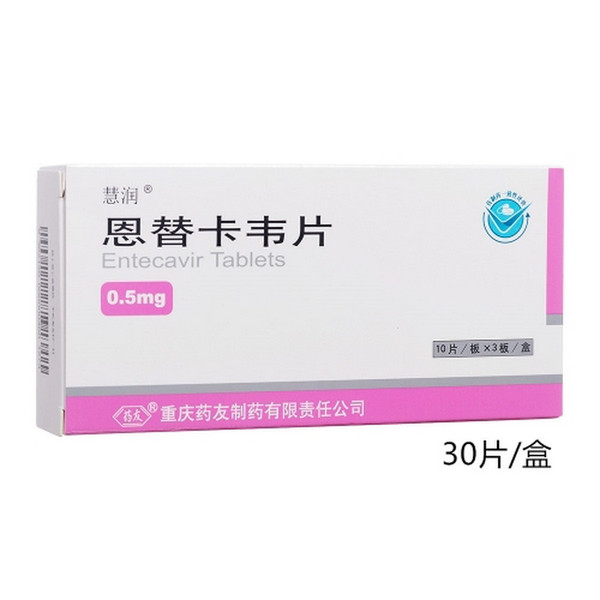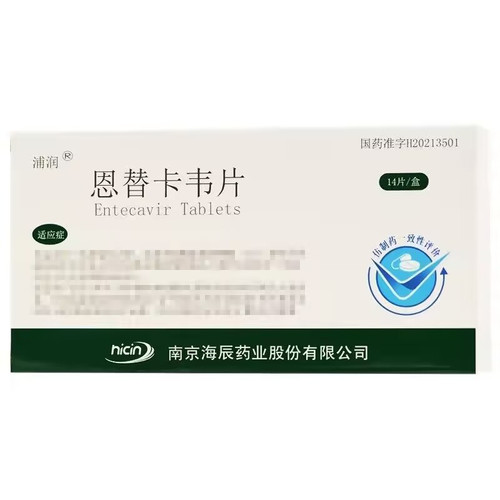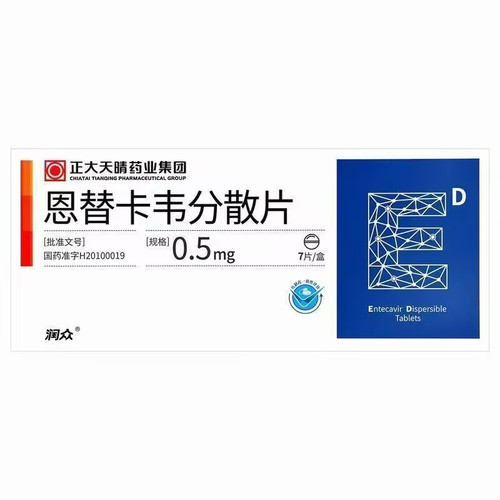Product Overview
[Drug Name]
Generic Name: Entecavir Tablets
Trade Name: HuiRun Entecavir Tablets 0.5mg*30 Tablets
Pinyin Full Code: HuiRunEnTiKaWeia 0.5mg*30 Tablets
[Main Ingredients]
The main ingredient of this product is Entecavir. Chemical Name: 2-Amino-9-{(1S.3R.4S)-4-hydroxy-3-hydroxymethyl-2-methylenecyclopentyl]-1,9-dihydro-6H-purin-6-one monohydrate.
[Indications/Main Functions]
Indicated for the treatment of chronic hepatitis B in adults with active viral replication, persistently elevated serum alanine aminotransferase (ALT), or active liver histological lesions. Also indicated for the treatment of pediatric patients aged 2 to <18 years with chronic HBV infection and compensated liver disease who are treatment-naive and have evidence of active viral replication, persistently elevated serum ALT levels, or histological evidence of moderate to severe inflammation and/or fibrosis.
[Specifications]
0.5mg*30 tablets
[Dosage and Administration]
This product should be taken under the guidance of an experienced physician. Entecavir tablets should be taken on an empty stomach (at least 2 hours before or after a meal). Recommended dose: Adults, take 0.5mg orally once daily (0.5mg: 1 tablet). Patients who develop viremia or lamivudine-resistant mutations during lamivudine treatment should take 1.0mg once daily (0.5mg: 2 tablets; 1.0mg: 1 tablet). Treatment decisions for children should carefully consider individual patient needs and refer to current pediatric treatment guidelines, including valuable baseline histological information. The benefits of long-term virologic suppression with continuous therapy must be weighed against the risks of extended treatment, including the emergence of drug-resistant HBV. For HBeAg-positive children with compensated chronic hepatitis B, elevated serum ALT levels should have persisted for at least 6 months prior to treatment, and for HBeAg-negative children, for at least 12 months. Patients weighing 32.6 kg or more should receive 0.5 mg of entecavir (0.5 mg per tablet) daily, with or without food. Patients weighing less than 32.6 kg should use the oral solution.
[Adverse Reactions]
Adverse reactions in adult patients were evaluated based on four global clinical trials: A1463014, A1463022, A1463026, and A1463027, as well as three clinical trials conducted in China (A1463012, A1463023, and A463056). A total of 2,596 patients with chronic hepatitis B were enrolled in these seven studies. In studies comparing entecavir to lamivudine, adverse events and laboratory abnormalities were similar. In studies conducted internationally, the most common adverse events with entecavir were headache, fatigue, dizziness, and nausea. Common adverse events in patients treated with lamivudine included headache, fatigue, and dizziness. Across the four studies, 1% of entecavir-treated patients and 4% of lamivudine-treated patients withdrew from the studies due to adverse events and abnormal laboratory test values, respectively.
[Contraindications]
Huirun Entecavir Tablets should not be used by patients with hypersensitivity to this product or any component of the formulation.
[Drug Interactions]
The metabolism of entecavir was evaluated in vitro and in vivo. Entecavir is not a substrate, inhibitor, or inducer of the cytochrome P450 (CYP450) enzyme system. At concentrations approximately 1000 times the human concentration, entecavir does not inhibit any of the major human CYP450 enzymes: 1A2, 2C9, 2C19, 2D6, 3A4, 2B6, and 2E1. At concentrations approximately 340 times the human concentration, entecavir does not induce any of the human CYP450 enzymes: 1A2, 2C9, 2C19, 3A4, 3A5, and 2B6. Concomitant administration of drugs metabolized by CYP450 inhibitors or inducers has no effect on the pharmacokinetics of entecavir. Furthermore, concomitant administration of entecavir has no effect on the pharmacokinetics of known CYP substrates. Studies of the interaction of entecavir with lamivudine, adefovir, and tenofovir revealed no alterations in the steady-state pharmacokinetics of either entecavir or the interacting drugs. Because entecavir is primarily eliminated through the kidneys, concurrent administration of entecavir with drugs that reduce renal function or compete for active glomerular secretion may increase the plasma concentrations of these drugs. Concomitant administration of entecavir with lamivudine, adefovir, or tenofovir does not result in significant drug interactions. Concomitant administration of entecavir with other drugs that are eliminated through the kidneys or are known to affect renal function has not been studied. Patients should be closely monitored for adverse reactions when taking entecavir concomitantly with such drugs.
[Precautions]
1. Severe Acute Exacerbations of Hepatitis B: Severe acute exacerbations of disease have been reported in patients after discontinuation of hepatitis B antiviral therapy (including entecavir). Patients who discontinue hepatitis B antiviral treatment should have their liver function closely monitored for at least several months. If necessary, antiviral therapy should be restarted. 2. HIV Co-infection: Entecavir has not been evaluated in patients with HBV and HIV co-infection who are not receiving effective HIV treatment. Limited clinical experience suggests that entecavir may develop resistance to HIV nucleocapsid reverse transcriptase inhibitors if used in patients with chronic hepatitis B and HIV co-infection who are not receiving antiretroviral therapy. Therefore, entecavir is not recommended for patients with HBV and HIV co-infection who are not receiving highly active antiretroviral therapy (HAART). All patients should be tested for HIV antibodies before starting entecavir treatment. Entecavir has not been studied for the treatment of HIV infection; therefore, entecavir is not recommended for HIV treatment. 3. Lactic Acidosis and Severe Hepatomegaly with Steatosis: Cases of lactic acidosis, hepatomegaly with steatosis, and even death have been reported following treatment with nucleocapsid analogs alone or in combination with antiretroviral drugs. The majority of patients experiencing these events are women. Obesity and prolonged use of nucleoside analogs may be risk factors for these adverse events. Patients with these risk factors should exercise caution when using nucleoside analogs for liver disease; however, such events have also occurred in patients without these risk factors. Lactic acidosis has been reported in patients receiving entecavir, often associated with hepatic decompensation or other serious medical conditions or drug exposure. Patients with hepatic decompensation are at increased risk for lactic acidosis. If clinical or laboratory findings suggest lactic acidosis or significant hepatotoxicity (which may include hepatomegaly and steatosis, even in the absence of significant aminotransferase elevations), Huirun Entecavir tablets should be discontinued.
[Pediatric Use]
Clinical data for pediatric patients aged 2 to <18 years are derived from international entecavir clinical trials.
[Elderly Use]
Due to the lack of sufficient entecavir clinical studies with patients aged 65 years and older, it is unclear whether elderly patients respond differently to entecavir than younger patients. Other clinical trial reports have not found differences between elderly and younger patients. Entecavir is primarily excreted by the kidneys, and the risk of toxic reactions may be higher in patients with renal impairment. Because elderly patients often have decreased renal function, careful dosing and renal function monitoring are recommended.
[Overdose]
There have been no reports of overdose with entecavir. No increase in adverse events has been observed in healthy individuals following a single dose of up to 40 mg or multiple doses of 20 mg/day for 14 consecutive days. If an overdose occurs, monitor the patient for toxicity and administer standard supportive care as necessary. After a single dose of 1.0 mg of entecavir, approximately 13% of entecavir is eliminated by hemodialysis over 4 hours.






